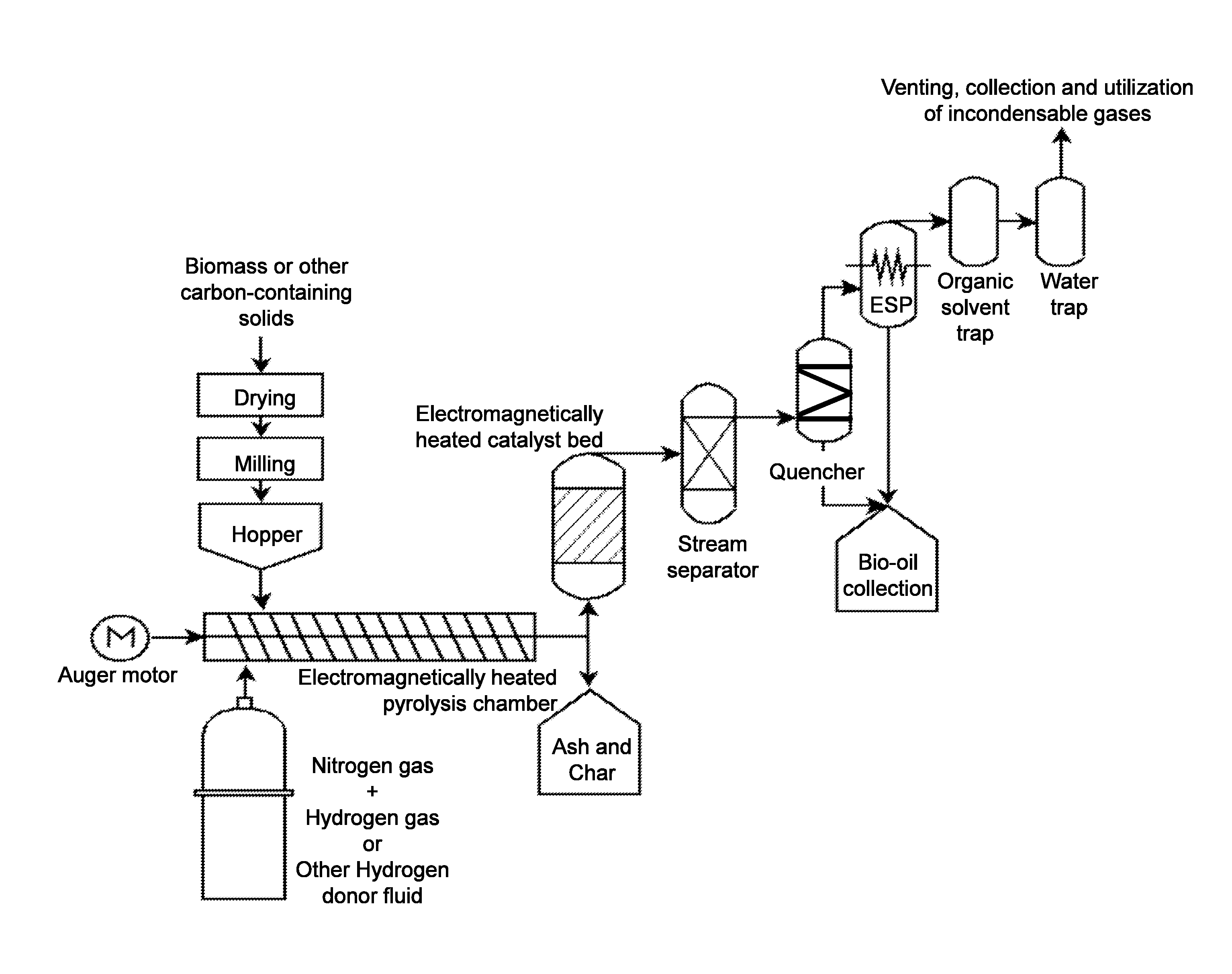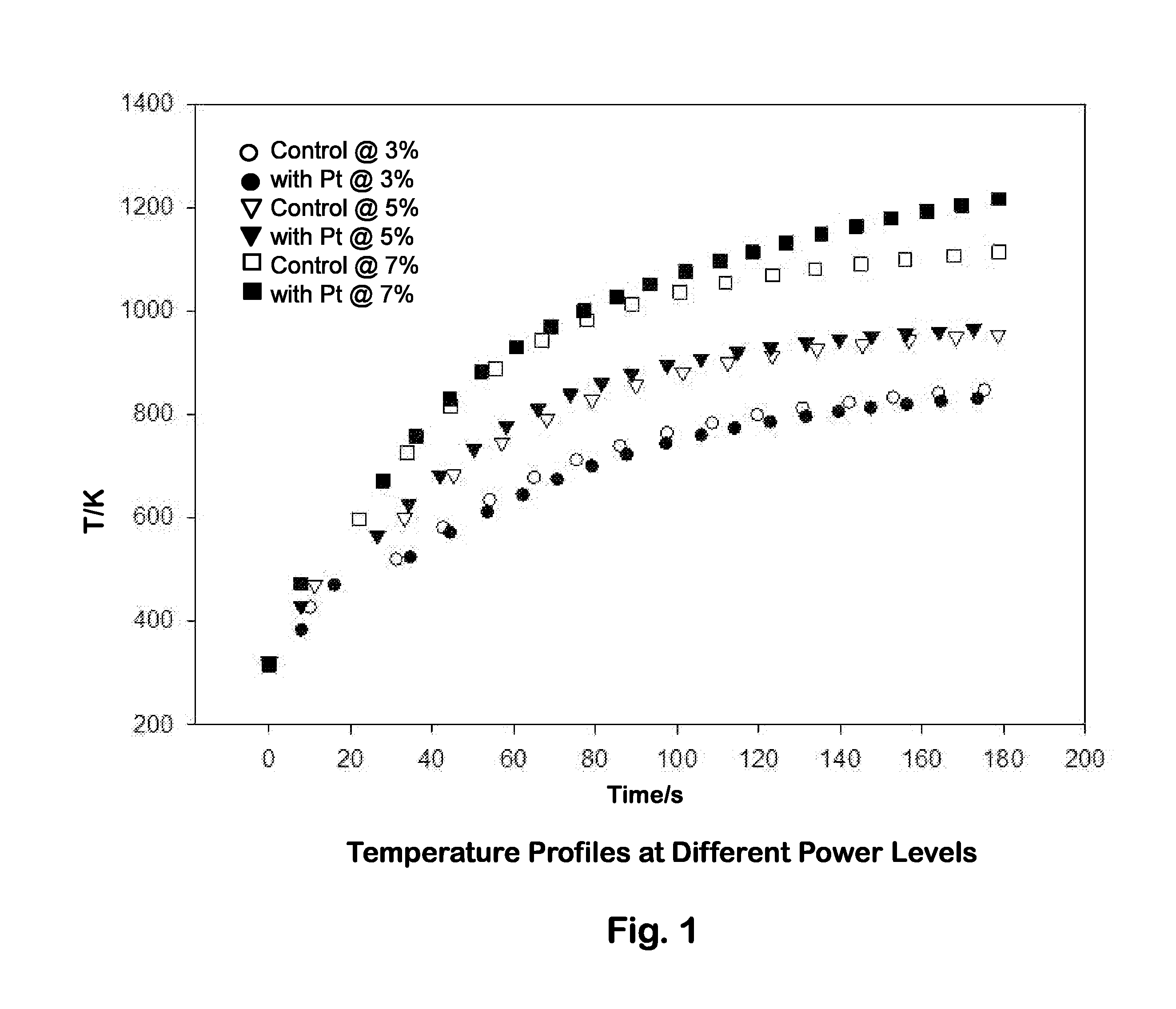Catalysts Useful for Biomass Pyrolysis and Bio-Oil Upgrading
a biomass pyrolysis and bio-oil technology, applied in the field of catalysts, can solve the problems of non-uniform heating and limited heat transfer in previous approaches, and achieve the effect of improving fuel quality
- Summary
- Abstract
- Description
- Claims
- Application Information
AI Technical Summary
Benefits of technology
Problems solved by technology
Method used
Image
Examples
example 1
Catalyst / Substrate Production
[0074]A Pt-stainless steel substrate was produced by chemically reducing Pt(s) from platinum salt onto the surfaces of stainless steel particles. The deposition process used formaldehyde as the reducing agent, sodium hydroxide as a stabilizing agent, and chloroplatinic acid hexahydrate solution as the platinum source.
[0075]Stainless steel particles (type 316, diameter 4.8 mm) were first washed with deionized water and ethanol, and then dried in an oven at ˜100° C. The surface of the stainless steel was then plasma-oxidized for 30 sec in vacuum, chemically converting the metal surface into its oxide. This primed the surface for coupling with a silane linker, which acted as a coupling agent between organic and inorganic materials. The silane linker was formed by hydrolyzing alkoxy groups in the molecule to form a silanol. The hydroxyl groups were then hydrogen-bonded to the substrate, releasing water molecules.
example 2
Catalyst Analysis After Induction Heating
[0082]The platinum-functionalized stainless steel balls were heated with an induction heater at a higher frequency (˜150 to ˜400 kHz) at three different power levels: 150 W (3%), 250 W (5%) and 350 W (7%). Thermal characteristics were compared to those of untreated stainless steel balls. Three stainless steel balls (functionalized or untreated) were placed in a ceramic crucible and heated inside the induction coil during each run.
[0083]Temperature plots compared steel balls with Pt to steel balls without Pt at three power levels: 3%, 5%, and 7% (output=5 kW), as a function of time. As illustrated in FIG. 1, only minor differences in temperature profiles were observed; the platinum deposition did not substantially alter the temperature reached by the stainless steel balls when heated with an induction coil. The temperature profiles were fitted to a simple exponential curve, with three parameters (T0, a, and b):
T(K)=T0+a* (1−bt(s))
[0084]The hea...
example 3
Systems for Induction Pyrolysis
[0087]One embodiment of the present invention employed the catalyst in an induction heating system (RDO-LF model no. 5-35 / 100-3). A range of temperatures from 400° C. to 800° C. was tested to determine the effect on liquid pyrolysis yield. The induction heater was a low frequency model (RDO Induction LLC, Washington, N.J.) operated in the range 35-100 kHz using a 5 kW power supply. The reaction tube was a 310-stainless steel tri-clamp tube, 419 mm length, 34.4 mm inner diameter, and 38.1 mm outer diameter. An outlet with a 16.5 mm inner diameter was located 29.4 mm from the end of the reaction tube connected to the inlet airflow. The system was purged of oxygen using a continuous flow of argon gas at 1 L / min.
[0088]FIG. 3a schematically depicts a prototype embodiment of the pyrolysis setup. The induction coil was a ten-loop, rubber-coated copper coil with an overall length of 285 mm and an inner diameter of 59 mm. The reaction tube temperature was monit...
PUM
| Property | Measurement | Unit |
|---|---|---|
| Temperature | aaaaa | aaaaa |
| Temperature | aaaaa | aaaaa |
| Length | aaaaa | aaaaa |
Abstract
Description
Claims
Application Information
 Login to View More
Login to View More - R&D
- Intellectual Property
- Life Sciences
- Materials
- Tech Scout
- Unparalleled Data Quality
- Higher Quality Content
- 60% Fewer Hallucinations
Browse by: Latest US Patents, China's latest patents, Technical Efficacy Thesaurus, Application Domain, Technology Topic, Popular Technical Reports.
© 2025 PatSnap. All rights reserved.Legal|Privacy policy|Modern Slavery Act Transparency Statement|Sitemap|About US| Contact US: help@patsnap.com



